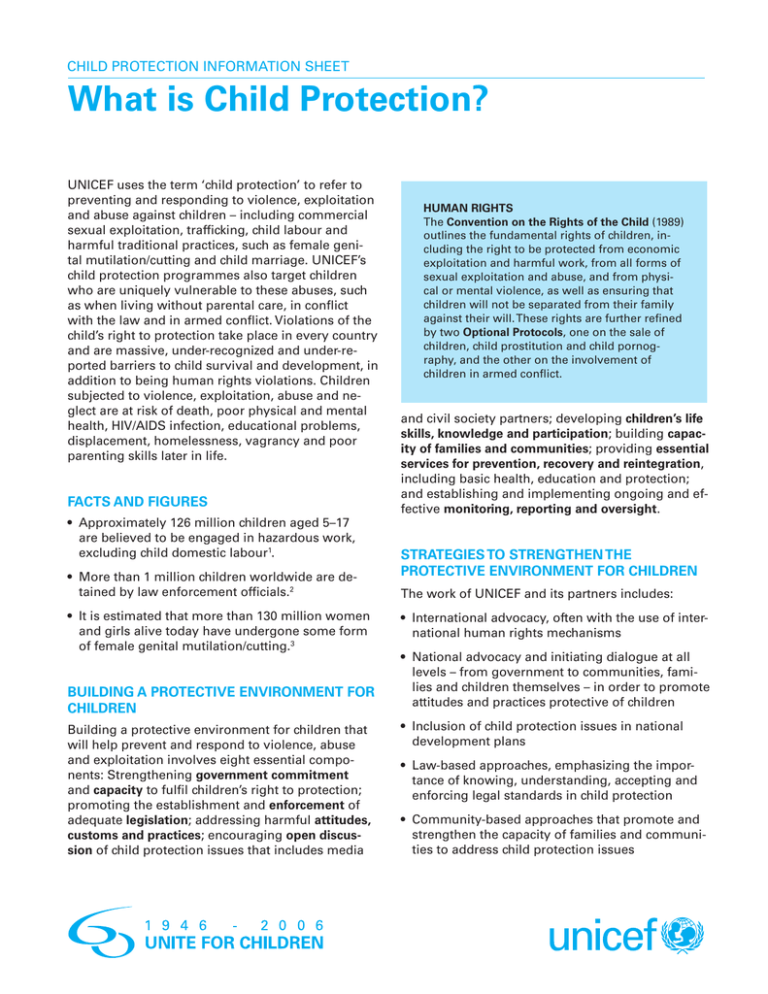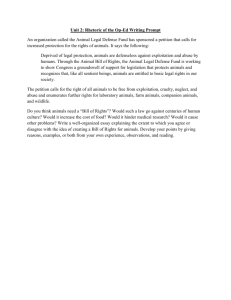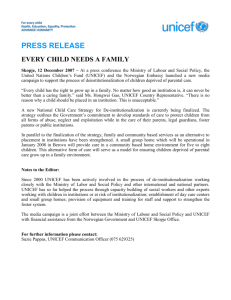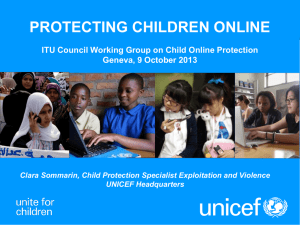
Child Protection INFORMATION Sheet
What is Child Protection?
UNICEF uses the term ‘child protection’ to refer to
preventing and responding to violence, exploitation
and abuse against children – including commercial
sexual exploitation, trafficking, child labour and
harmful traditional practices, such as female genital mutilation/cutting and child marriage. UNICEF’s
child protection programmes also target children
who are uniquely vulnerable to these abuses, such
as when living without parental care, in conflict
with the law and in armed conflict. Violations of the
child’s right to protection take place in every country
and are massive, under-recognized and under-reported barriers to child survival and development, in
addition to being human rights violations. Children
subjected to violence, exploitation, abuse and neglect are at risk of death, poor physical and mental
health, HIV/AIDS infection, educational problems,
displacement, homelessness, vagrancy and poor
parenting skills later in life.
Facts and figures
•Approximately 126 million children aged 5–17
are believed to be engaged in hazardous work,
excluding child domestic labour1.
•More than 1 million children worldwide are detained by law enforcement officials.2
•It is estimated that more than 130 million women
and girls alive today have undergone some form
of female genital mutilation/cutting.3
BUILDING A PROTECTIVE ENVIRONMENT FOR
CHILDREN
Building a protective environment for children that
will help prevent and respond to violence, abuse
and exploitation involves eight essential components: Strengthening government commitment
and capacity to fulfil children’s right to protection;
promoting the establishment and enforcement of
adequate legislation; addressing harmful attitudes,
customs and practices; encouraging open discussion of child protection issues that includes media
HUMAN RIGHTS
The Convention on the Rights of the Child (1989)
outlines the fundamental rights of children, including the right to be protected from economic
exploitation and harmful work, from all forms of
sexual exploitation and abuse, and from physical or mental violence, as well as ensuring that
children will not be separated from their family
against their will. These rights are further refined
by two Optional Protocols, one on the sale of
children, child prostitution and child pornography, and the other on the involvement of
children in armed conflict.
and civil society partners; developing children’s life
skills, knowledge and participation; building capacity of families and communities; providing essential
services for prevention, recovery and reintegration,
including basic health, education and protection;
and establishing and implementing ongoing and effective monitoring, reporting and oversight.
Strategies to strengthen the
protective environment for children
The work of UNICEF and its partners includes:
•International advocacy, often with the use of international human rights mechanisms
•National advocacy and initiating dialogue at all
levels – from government to communities, families and children themselves – in order to promote
attitudes and practices protective of children
•Inclusion of child protection issues in national
development plans
•Law-based approaches, emphasizing the importance of knowing, understanding, accepting and
enforcing legal standards in child protection
•Community-based approaches that promote and
strengthen the capacity of families and communities to address child protection issues
Child Protection INFORMATION Sheet: WHAT IS CHILD PROTECTION?
•Partnerships with governments, non-governmental and faith-based organizations, other United
Nations organizations, professional associations,
children and youth, and the media.
KEY Results Expected FOR 2006–2009
•Ensuring that government decisions are increasingly influenced by better knowledge and awareness of child protection rights and improved data
and analysis on child protection issues
•Supporting effective legislative and enforcement
systems – along with improved protection and
response capacity – to protect children from all
forms of abuse, neglect, exploitation and violence, including exploitative child labour
Millennium Development Goals
Child protection issues intersect with every one
of the Millennium Development Goals (MDGs)
– from poverty reduction to getting children into
school, from eliminating gender inequality to
reducing child mortality.
Most of the MDGs simply cannot be achieved
if failures to protect children are not addressed.
Child labour squanders a nation’s human capital
and conflicts with eradicating extreme poverty
(MDG 1); armed conflict disrupts efforts to achieve
universal primary education (MDG 2); child marriage leads to the removal of girls from school
and thus prevents gender equality (MDG 3); children separated from their mothers, particularly if
they remain in institutional settings, are at greater
risk of early death, which hinders efforts to reduce
child mortality (MDG 4); female genital mutilation/cutting undermines efforts to maternal health
(MDG 5); and sexual exploitation and abuse hamper efforts to combat HIV infection (MDG 6). In
addition, environmental disasters make children
vulnerable to exploitation and abuse, hence the
need for environmental sustainability (MDG 7).
Overall, protecting children requires close
cooperation between different partners, which
consolidates the need for a global partnership for
development (MDG 8).
For further information please contact:
The Child Protection Section
Programme Division UNICEF NY
childprotection@unicef.org
www.unicef.org
© The United Nations Children’s Fund (UNICEF)
May 2006
•Improving mechanisms to protect children from
the impact of armed conflict and natural disasters
•Addressing national justice systems to ensure
that mechanisms are in place to provide protection for children and adolescents as victims, witnesses and offenders
•Reducing the number of children separated from
their families and strengthening national capacities to ensure access by poor families to services
and safety nets needed to protect and care for
their children.
EXAMPLES OF UNICEF IN ACTION
•Working closely with parliamentarians on the
regional and country levels, including the launch
of handbooks for parliamentarians about child
protection (2004) and child trafficking (2005)
•Providing support to legal reforms of Criminal
Codes and the implementation of national plans
of action for the prevention of commercial sexual
exploitation and trafficking in Latin America and
the Caribbean
•Taking part in the development of juvenile justice
systems in at least 13 of the 20 countries of the
CEE/CIS region by assisting in legal reforms in
line with international standards, piloting service
models in the restorative justice approach, and
training specialized police units, judges and lawyers to apply new principles and standards for
children in conflict with the law.
Notes
1
International Labour Office, The End of Child Labour: Within
reach, Global Report under the follow-up to the ILO Declaration
on Fundamental Principles and Rights at Work, International Labour Conference, 95th Session 2006, Report I (B), ILO, Geneva,
2006.
2
Defence for Children International, ’No Kids Behind Bars: A
global campaign on justice for children in conflict with the law’,
<www.kidsbehindbars.org>.
3
nited Nations Children’s Fund, Female Genital Mutilation/CutU
ting: A statistical exploration 2005, UNICEF, New York, 2005, p. 1.



